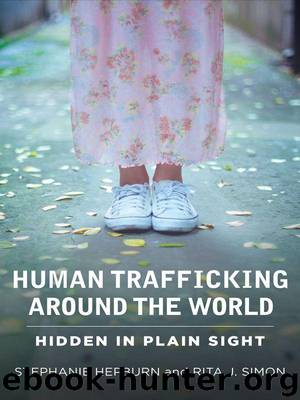Human Trafficking Around the World by Stephanie Hepburn

Author:Stephanie Hepburn
Language: eng
Format: mobi, epub
Tags: Law/Criminal Law, LAW026000, POL011000, Political Science/International Relations/General
Publisher: Columbia University Press
Published: 2013-06-03T16:00:00+00:00
Another concern is that forced-labor victims, particularly men, do not have the same access to services and shelters as victims of sexual exploitation. This form of trafficking often goes undiscovered, as it is not a focal point of internal anti-trafficking efforts. According to Bews, “Labor inspectors from the Department of Labor simply aren’t checking for this [trafficking for forced labor]. The reality is that without proper training they won’t detect it. It is a worrying situation.” And it is difficult to know how many victims have received assistance, because there are no official statistics, and law-enforcement records continue to classify victims of trafficking for commercial sexual exploitation as victims of domestic abuse, rape, and gender-based violence (U.S. Department of State, 2009). IOM shelter information reveals that in 2005 and 2006, 66 sex-trafficking victims (25 in 2005 and 41 in 2006) were sheltered by IOM compared to 27 victims of forced labor. However, awareness of forced labor among officials and service providers may be on the rise. For example, from 2005 to 2006 the number of forced-labor victims sheltered by IOM more than doubled, from 7 to 20 (UNODC, 2009). In 2011, 13 multipurpose shelters with staff trained to assist trafficking victims aided 59 trafficking victims (U.S. Department of State, 2012).
The victim breakdown in 13 criminal cases analyzed in the 2010 NPA report provides a glimpse into the identified forms of trafficking, the countries of origin, and the ages of those trafficked to and within South Africa (NPA/HSRC, 2010). The cases primarily involve trafficking for commercial sexual exploitation. One case involved trafficking for forced labor, and two toddlers (3 years old) were suspected to have been abducted and murdered for the removal of body parts. All the victims in the cases were female. Twenty of the girls and women were from eastern Europe, 15 from Thailand, 10 from South Africa, and 3 unknown. The victims trafficked from eastern Europe to South Africa were between the ages of 20 and 30. Those trafficked from Thailand to South Africa were age 18 and up; those trafficked within South Africa were from age 13 to the early twenties. Most of the victims trafficked within South Africa were under the age of 18. Four of the 13 cases were withdrawn because witnesses (the trafficking victims) disappeared before the cases went to trial (NPA/HSRC, 2010).
André Neethling, the SAPS provincial coordinator for child protection in Gauteng, says many trafficked girls are introduced to drugs soon after being abducted, and as a result are problematic witnesses. “These children are very erratic,” Neethling told Carte Blanche. “They would support you now. When they get the urge for drugs again, they would run away from the place of safety. So we have a very low success rate in terms of prosecution of these people [traffickers]” (Carte Blanche, 2007). One concern is not only the lack of prosecutions against traffickers but also the long delays in cases that do go forward. In 2010 Carol Bews noted that one case involving three
Download
Human Trafficking Around the World by Stephanie Hepburn.epub
This site does not store any files on its server. We only index and link to content provided by other sites. Please contact the content providers to delete copyright contents if any and email us, we'll remove relevant links or contents immediately.
| General | Discrimination & Racism |
Nudge - Improving Decisions about Health, Wealth, and Happiness by Thaler Sunstein(7509)
iGen by Jean M. Twenge(5345)
The Fire Next Time by James Baldwin(5218)
Adulting by Kelly Williams Brown(4458)
The Hacking of the American Mind by Robert H. Lustig(4286)
The Sports Rules Book by Human Kinetics(4248)
The Ethical Slut by Janet W. Hardy(4157)
Captivate by Vanessa Van Edwards(3780)
Mummy Knew by Lisa James(3602)
In a Sunburned Country by Bill Bryson(3464)
The Worm at the Core by Sheldon Solomon(3410)
Ants Among Elephants by Sujatha Gidla(3385)
Suicide: A Study in Sociology by Emile Durkheim(2959)
The 48 laws of power by Robert Greene & Joost Elffers(2940)
The Slow Fix: Solve Problems, Work Smarter, and Live Better In a World Addicted to Speed by Carl Honore(2927)
Humans of New York by Brandon Stanton(2784)
The Tipping Point by Malcolm Gladwell(2665)
Handbook of Forensic Sociology and Psychology by Stephen J. Morewitz & Mark L. Goldstein(2647)
The Happy Hooker by Xaviera Hollander(2637)
